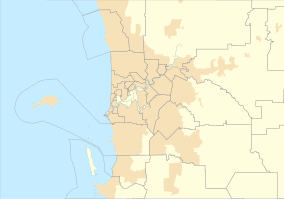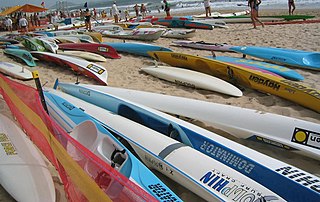
Surf lifesaving is a multifaceted social movement that comprises key aspects of voluntary lifeguard services and competitive surf sport. Originating in early 20th century Australia, the movement has expanded globally to other countries, including New Zealand, Ireland, South Africa, and the United Kingdom. Surf lifesavers in Australia are colloquially known as "Clubbies".

Cottesloe is a western suburb of Perth, Western Australia, within the Town of Cottesloe. Cottesloe was named for Thomas Fremantle, 1st Baron Cottesloe, a prominent Tory politician and the brother of Admiral Sir Charles Fremantle for whom the city of Fremantle was named. The nearby suburb of Swanbourne was named for the Fremantle family seat, Swanbourne House, in Swanbourne, Buckinghamshire.

Swanbourne is a western coastal suburb of Perth, Western Australia, located within the City of Nedlands. It is an affluent, upper middle class residential area with older Federation style homes, many being renovated. The suburb was established in the late 19th century. New housing estates have been built recently through the redevelopment of areas such as the Swanbourne Senior High School, Swanbourne Primary School and Lakeway Drive-In Cinema sites.

Mullaloo is a northern coastal suburb of Perth, Western Australia, within the City of Joondalup.

The Rottnest Channel Swim is an annual open water swimming event from Cottesloe Beach through Gage Roads to Rottnest Island, off the coast of Western Australia, near Perth.
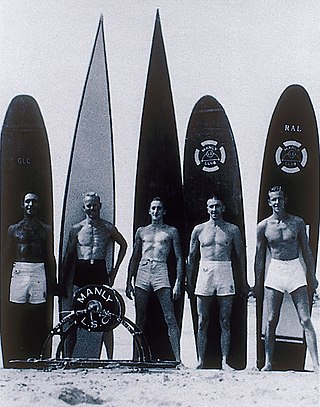
The Manly Life Saving Club is one of Australia's oldest Surf Life Saving Clubs, founded in 1911; located in the Sydney suburb of Manly, in the Northern Beaches Council in New South Wales.

Surf Life Saving Australia (SLSA) is an Australian not-for-profit community organisation that promotes water safety and provides surf rescue services.

The Town of Cottesloe is a local government area in the western suburbs of Perth, the capital of Western Australia. It covers the suburb of the same name as well as a tiny portion of the suburb of Claremont. Cottesloe is located 11 kilometres (7 mi) west of Perth's central business district, covers an area of 3.9 square kilometres (1.5 sq mi), maintains 45.7 km of roads and had a population of approximately 7,500 as at the 2016 Census. Cottesloe is served by Swanbourne, Victoria Street, Grant Street and Cottesloe train stations, all operated through the Fremantle Railway Line. Various bus routes operate along Stirling Highway, enabling transport through the suburb's western and eastern precincts with Perth and Fremantle. All services are operated by the Public Transport Authority. The Town of Cottesloe's inclusion of walk and cycle paths enable it to be a walkable precinct.
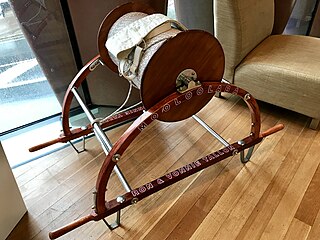
The surf life saving reel was a beach life saving apparatus from Australia.
The Bronte Surf Lifesaving Club (BSLSC) is a surf lifesaving club in Bronte, New South Wales, Australia. It was founded in 1903 and the movement has since spread to other parts of New South Wales and the rest of the country.

The Bondi Surf Pavilion in Sydney, New South Wales (NSW), Australia, is an outstanding beach cultural icon of Australia, together with the beach, park and surf lifesaving club. The structure is listed on the NSW State Heritage Register 01786 as well as by Waverley Council. The building has also been listed by the Heritage Council. According to the National Trust it "has come to represent the Australian culture of beach bathing and outdoors living".
The South Port Surf Lifesaving Club (SLSC) was established in 1959 in the coastal Adelaide suburb of Port Noarlunga, South Australia, and it is currently situated in the sand dunes at the mouth of the Onkaparinga River Estuary. Due to its location at the mouth of a major South Australian river and its position in Gulf St Vincent, South Port is a renowned surfing beach for both board riders and body surfers.
The Bondi Surf Bathers' Life Saving Club is Australia's oldest Surf Life Saving Club, founded in 1907. The club was officially established on 21 February 1907 at the Royal Hotel in Bondi, New South Wales. The club's aim is to ensure "No Lives Lost" at Bondi Beach and is a volunteer organisation that patrols Bondi Beach from October to April every year.

Main Beach Pavilion and Southport Surf Lifesaving Club are heritage-listed beach buildings off Macarthur Parade, Main Beach, Queensland, Australia. The Main Beach Pavilion was designed by Thomas Ramsay Hall and Lionel Blythewood Phillips of the architectural firm Hall and Phillips and built in 1934 for the Southport Town Council. The Surf Lifesaving Club was also designed by Hall and Phillips and built adjacent in 1936 for the club. They were added to the Queensland Heritage Register on 1 March 1995.
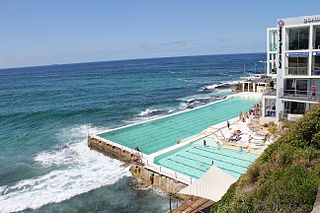
The Bondi Icebergs Swimming Club is an Australian winter swimmers club, located at the southern end of Bondi Beach in Sydney, New South Wales. The swimming club was established in 1929 and has a small museum on the first floor. A defining characteristic of the Club is a rule that to maintain membership it was mandatory that swimmers compete on three Sundays out of four for a period of five years.
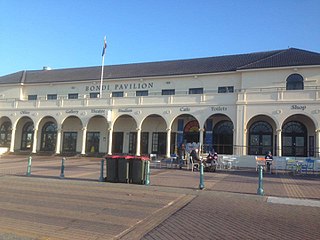
The Bondi Beach Cultural Landscape is a heritage-listed former Turkish baths, pavilion with dressing cubicles, dining rooms, sunbaking, shops and ballroom and now art gallery, pavilion, theatre and open air cinema located at Queen Elizabeth Drive, Bondi Beach, Sydney, Australia. The pavilion was designed by Robertson and Marks, with Leith C. McCredie the architect. The Bondi Surf Life Savers' Club, erected c. 1934, was designed by Ross & Rowe. The Bondi Pavilion was designed by John Howie & Sons. The cultural landscape includes the beach itself, Bondi Surf Pavilion, Bondi Park and Bondi Surf Life Saving Club and the North Bondi Surf Club. The landscape was added to the New South Wales State Heritage Register on 23 May 2008.

North Beach Precinct is a heritage-listed precinct at Cliff Road, North Wollongong, City of Wollongong, New South Wales, Australia. It includes North Wollongong Beach, the North Beach/Wollongong Bathing Pavilion, Puckey's Salt Works, the Tram Cutting, Battery Park and Smiths Hill. It was added to the New South Wales State Heritage Register on 17 June 2005.
The Freshwater Surf Life Saving Club, established in 1908, is located at Freshwater Beach in Australia. It has become a large volunteer organization with strong community bonds. The club was founded by a push from government to foster safer beach practices. It is a part of Surf Life Saving Australia, a not-for-profit organization committed to keeping the beach safe for patrons and providing beach rescue services. A visit to the club from United States' surfer, Duke Kahanamoku, in 1914 helped initiate the sport of surfing in Australia.

Lifesaving, also known as lifesaving sport, is a group of sports disciplines based on the practices of lifesaving.

